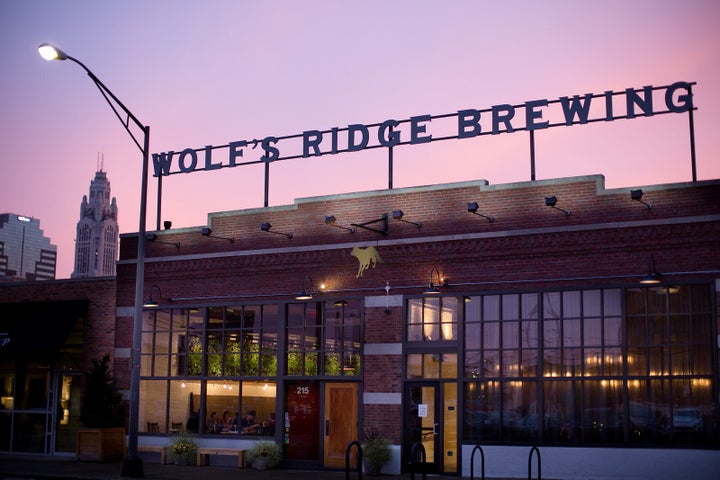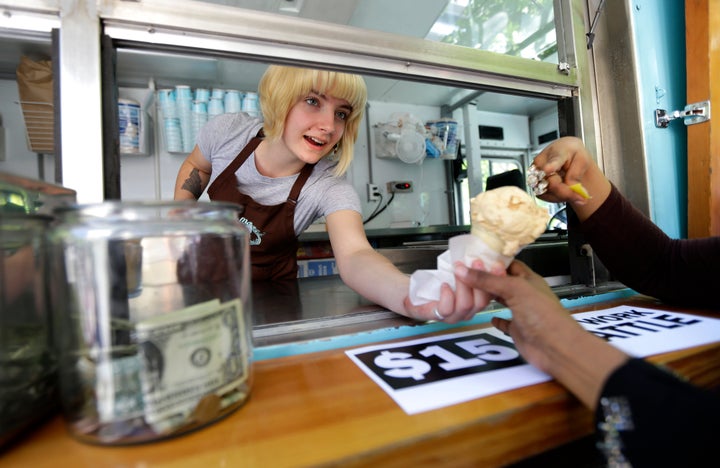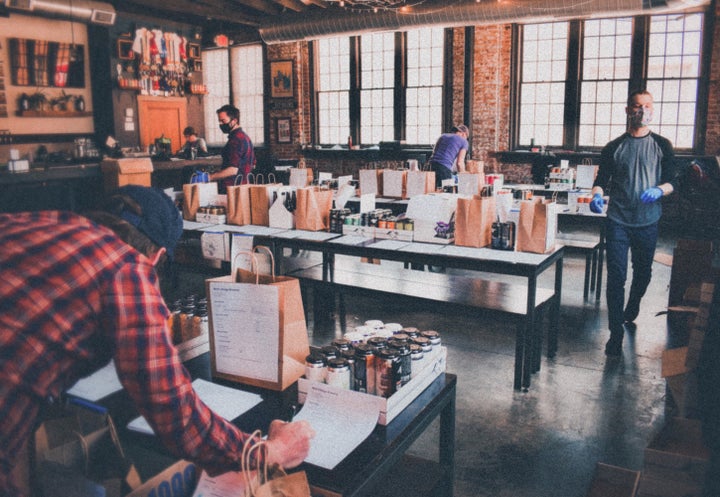This fall, like many small-business owners around the country, Bob Szuter, had a coronavirus problem. One of the employees at the restaurant and brewing company he owns in Columbus, Ohio, tested positive for COVID-19.
Normally, one sick worker is not a big deal. Szuter, who co-founded Wolf’s Ridge Brewing with his father seven years ago, gives everyone paid time off every year. But this is a pandemic. That one worker had come into contact with nine other employees. Altogether, that was more than 20% of his staff.
“Normally, if someone had to take two weeks off to deal with something, we would’ve taken care of them,” he told HuffPost. “But we’ve been stretched so thin, it’s hard to do that at this point.”

And yet, Szuter was able to pay all 10 employees to stay home. All thanks to a little-known paid leave program established by Congress as part of the second stimulus package passed in March.
Under the program, employees can take two weeks of sick leave, fully paid up to a maximum amount, or up to 12 weeks off, including 10 weeks paid at two-thirds of their salary, to care for kids who aren’t able to go to school. Business owners are fully reimbursed for the expense via a tax credit.
“It’s one of the provisions that had actually made it easier for us to deal with the pandemic,” Szuter said. He’s used the benefit to give 15 workers paid sick time during the crisis, he said.
Throughout the pandemic, public health experts, economists and paid leave advocates have pushed for the government to simply pay workers to stay home until COVID-19 is under control, particularly in sectors where employees are in close contact with the public. This paid leave program has been doing that, despite many obstacles. Yet, the whole program is set to expire at the end of December, leaving the more than 87 million workers potentially covered by the provision ― and their employers ― in the lurch, and possibly posing a further health risk.
“It’s expiring at the worst possible time,” Szuter said. Infection rates are high in the county where his business operates. Finding anyone who wants to work in a restaurant during the pandemic is hard enough, but the ability to pay folks who have to stay home to quarantine was an appealing benefit.
“Throughout the pandemic, public health experts, economists and paid leave advocates have pushed for the government to simply pay workers to stay home until COVID-19 is under control. ... This paid leave program has been doing that.”
And there’s little sign lawmakers will extend the program, which was passed as part of the second COVID-19 relief bill, the Families First Coronavirus Response Act.
There is no provision for paid leave in the $908 billion coronavirus relief package currently gaining bipartisan traction in Congress. Instead, it includes money for more unemployment benefits, for vaccine distribution, for state and local governments, and for loans to small businesses.
Small-Business Owners Actually Like This
The paid leave program hasn’t been well-advertised, but it’s well-liked by the small-business owners who have managed to find out about it, said Sarah Crozier, the communications director at Main Street Alliance, a progressive group that represents about 30,000 businesses throughout the country.
“Across our membership, we’ve only heard rave reviews,” she said. “Extend and expand it is the rallying cry.”
She compared the leave provisions to the $525 billion small-business loan program, the Paycheck Protection Program, established as part of the other stimulus package passed in March. Many small-business owners weren’t able to access the loans, she said, or were confused by the program’s restrictions. Recently released data reveals that much of the money went to already deep-pocketed business owners who were less in need of help
By comparison, the paid leave provision has been much simpler to figure out, small-business owners told HuffPost, particularly for those who use payroll software, which has made it simple to do the back-end work.
It’s also cheaper. In the spring, the Congressional Budget Office estimated it would cost $105 billion. Though the number of businesses that report using the program might increase as more companies file taxes after the end of the year, it’s already clear that far fewer workers tapped the program than expected, said Chantel Boyens, a principal policy associate at the Urban Institute.
“We’re looking at a cost that’s a fifth of what you’d expect if you were going off the initial estimate,” she said.
Primarily, that’s because millions of workers just lost their jobs, she said. Instead of getting paid to take time off from work, they got unemployment checks.
It’s also because the Department of Labor, run by Eugene Scalia, did little to get the word out about the benefit.
Crozier said it should be a no-brainer to extend the program in any new stimulus package. Advocates of paid leave also want Congress to include more employers in the provision. This spring, Republicans and big-business lobbyists succeeded in narrowing the leave to cover only companies with 500 or fewer employees.
Still, about 65 million private sector workers and 22 million public sector employees are eligible for the sick leave, according to an estimate from the National Partnership for Women & Families.
Republican senators are pushing instead for some kind of “immunity shield” for companies to protect them from getting sued over coronavirus-related issues (like, say, not letting employees stay home if they’re sick).
A robust sick leave policy would go a long way to prevent employers from getting sued in the first place. Workers who could tap paid time off would be more likely to stay home when they’re sick ― or when they’ve been exposed to COVID-19.
“To push for immunity and not push for leave is just hypocritical,” Crozier said.
President-elect Joe Biden’s plan to combat the coronavirus does include an expansion of the provisions, but it’s not at all clear if he can get those passed in Congress.
Tom Frieden, the former head of the Centers for Disease Control and Prevention, joined several other public health experts urging Congress to extend the benefits in a letter sent Monday.
“Paid sick leave can reduce the spread of COVID-19 in workplaces and communities by removing the barrier to employees staying home if they might have the virus. Even one infection can set off an outbreak,” reads the letter.
This Keeps Women In The Workforce
Molly Moon Neitzel started her ice cream business, Molly Moon’s, in Seattle just a few months before the last recession in 2008. That was fine, she said. Better than fine, actually. Ice cream is typically a recession-proof business. People who are broke will still treat themselves to a cone.
This current economic downturn is “totally different,” she said.
Fewer folks are willing to risk their health for a scoop of Molly’s bestselling Yeti flavor (sweet cream ice cream with granola, chocolate chunks and a caramel ribbon). Business across her nine scoop shops is down 40% compared with last year.

“I did feel like it was an existential crisis, as to whether my company would survive,” she said, adding that now she’s on stronger footing.
Neitzel said about a dozen workers have used the leave program, but it’s particularly helped three single mothers who work in her shop and are using the leave intermittently while they keep working. They’ve been able to be home with their children, who are doing virtual school, and still get paid.
“If it expires, what are we going to tell them?” she asked.
She said the leave program has probably saved her business about $12,000. It may not be as valuable as the $734,000 Paycheck Protection Program loan she got, but it’s definitely life-changing for those women.
Neitzel provides workers with unusually good benefits, including starting hourly pay of $18, health and dental insurance, and all the free ice cream they can eat. She said she will do what it takes to keep those women on her payroll if the benefit expires.
“I really think this should be coming from the government, though,” she said.
The paid leave program is particularly crucial for parents during the pandemic, particularly mothers who are supporting their children in virtual school and trying to work. Already, a huge number of women have left the workforce ― particularly low-income workers and women of color who cannot work remotely.
Lisa Hemmerle, a 48-year-old mother in Andover, Massachusetts, who works for a nearby city government, has been using the paid leave benefits intermittently in order to stay home with her 6-year-old son while he’s doing remote school.
Her husband, who also works in a municipal government role, is also taking the leave.
They basically switch off. She stays home a few days a week with their son, and then he stays home a few days. Hemmerle isn’t sure how they’ll manage when the leave expires.
“I have so much anxiety,” she said. “I have refused to think about it.” She’s hoping Congress will extend the program.

Call it the ice cream hookup: Charlie Beaton, who owns Montana’s Big Dipper Ice Cream chain, only found out about the COVID-19 paid leave after talking to Neitzel, who owns the scoop shop in Seattle. They’ve known each other for years.
“A lot of people were in the dark,” Beaton said.
The pandemic has been frustrating for a lot of reasons, Beaton said. Quarantines have been one of them. It’s difficult to not only pay the people who miss work, but to also pay people to work in their place. He’s used the COVID-19 leave program to pay for 15 workers to quarantine ― out of 60 employees.
Beaton said another business in the area was forced to close after a number of employees quarantined. “We’re a well-established business. We’re gonna make it. There are some businesses that probably haven’t taken advantage of this that should,” he said.
In addition to failing to publicize the program, the Labor Department also made it easy for employers with fewer than 50 workers to opt out of participating. And it wrote a very broad exemption for health care workers that included folks like janitors in hospitals.
Boyens from the Urban Institute said more businesses might start using the leave program if it is extended and pointed out it provides a good bang for the buck.
“Paid leave is a great deal right now,” she said. The measure is also good for public health, she added.
One study estimates that the paid leave benefits prevented thousands of COVID-19 cases.
“It’s an opportunity to do something for the economy and the pandemic and it comes with a lower price tag,” Boyens said.

The program also is particularly beneficial to the struggling restaurant industry, Szuter, the brewpub owner in Ohio, told HuffPost.
Restaurant workers are in a terrible bind right now: If they come to work, they’re getting less money than usual. And they’re facing all the health risks of working in a pandemic. Szuter’s employees are also still dealing with customers who refuse to wear masks, he said.
Szuter already laid off more than 20 people to deal with the pandemic-related decline in business. His remaining employees work fewer hours, for less pay. And the work is different, to say the least. Staff who used to tend bar or wait tables, for example, are now driving vans to deliver beer around the state. Revenue is down by 40% for the year.
“It’s hard to find people interested in what we’re doing and willing to deal with the bullshit,” he said. Without this benefit, he added, he might not be able to pay folks who need to quarantine. “That’s going to make it really hard.”
- Which airlines are blocking out middle seats for holiday travel?
- How does the coronavirus spread differently than the flu?
- Can you close your COVID “bubble” without losing friends forever?
- Is it safe to see grandparents over the holidays?
- How can you help a friend with anxiety when you’re also struggling?
Everyone deserves accurate information about COVID-19. Support journalism without a paywall — and keep it free for everyone — by becoming a HuffPost member today.
